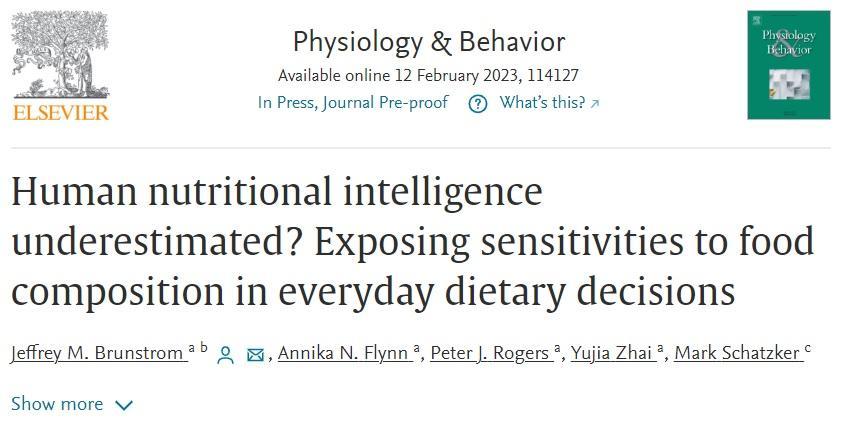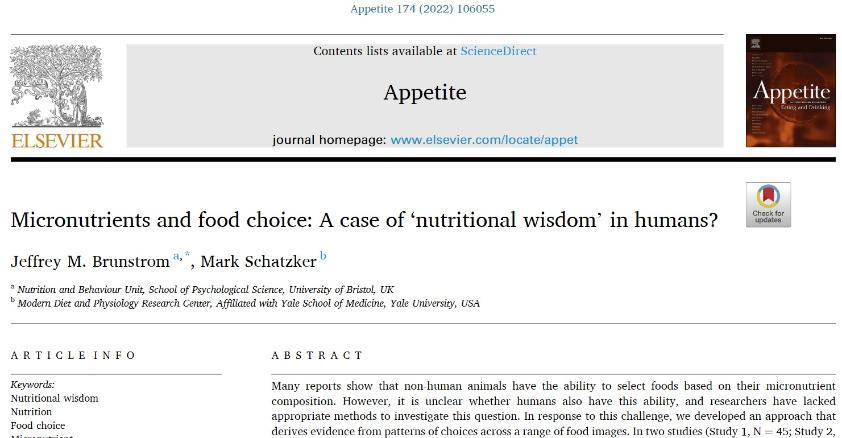Nutritional Intelligence
Not so dumb after all: Exposing hidden ‘nutritional intelligence’ in modern humans
Jeff Brunstrom, Peter Rogers, Annika Flynn, Yujia Zhai, and Mark Schatzker
Overview – introducing nutritional intelligence
How many headlines have been published claiming that our growing waistlines are caused by mindless overconsumption of ‘supersized’ energy-rich foods? How many times have we been told that humans are ‘dumb’ when it comes to deciding what and how much food to put on their plate? But what if there was a headline saying the opposite and that we’re only just beginning to appreciate human ‘nutritional intelligence’? Subjectively, our interaction with food ‘feels’ intelligent, but demonstrating this has proved remarkably difficult. In response to this challenge, our group has been looking at how people select foods and portion sizes.
On closer inspection, our work shows that people are surprisingly sensitive to the composition of food. For example, we tend to ascribe relatively greater value to foods that contain protein [1] and we have an amazing ability to predict the extent to which a food is going to be filling [2] and whether it will stave off hunger [3].
More recently, we’ve been looking at the effects of calorie density. People show tremendous sensitivity to differences in food energy density (kcal/g) and choose foods on this basis [4], and this ability can have a dramatic impact on the amount of food that we consume in a meal [5]. You can read more about our work on food energy density in the section "Human sensitivity to food energy density" below.
But we should also remember that calories are only part of the problem. To survive and stay healthy we need to choose a balanced diet that, amongst other things, incorporates essential vitamins and minerals. Here, the prevailing view is that humans solve this problem through ‘variety seeking’. In other words, we ensure we get a balanced diet merely through chance encounters with different foods, combined with a simple tendency to avoid eating the same food repeatedly. Our work appears to challenge this idea. People often like to pair foods together in a meal (e.g., burger and fries). These food pairings aren’t random! Working with Mark Schatzker, our studies indicate an amazing ability. Foods that deliver a broader range of micronutrients are more likely to be paired, suggesting a remarkable ability to choose a diet that maximises micronutrient availability. You can read more in the section "Micronutrients and food choice" below.
So where does our nutritional intelligence come from? Humans care a lot about flavour, and cuisine really matters to us. As scientists we often overlook or even ‘control out’ this powerful influence on our eating behaviour. But in the real world, ‘good’ recipes are prized, spices and herbs are painstakingly added to all manner of dishes, and bakers agonise over the texture of their crumb. If food preference provides little biological advantage, then why has this preoccupation been preserved, especially in food-secure societies where food is abundant?
In a recent article, we argue that traditional cuisine evolved because it serves a functional role. Individually, we can learn about the nutritional properties of a food, but this is highly inefficient and prone to error. However, if we combine this learning, then it means that both the burden and benefits can be shared with others, through social transmission. Nature provides the ingredients, but a cuisine brings them together to form a set of recipes. Learning to discriminate meals rather than ingredients is optimal because it enables us to evolve a combined culinary repertoire that maximises food security, while optimising our capacity to meet micro- and macronutrient requirements. Viewed in this way, our suggestion is that cuisine and associated cultural knowhow operates rather like an ‘instruction manual’ that can be passed down through oral tradition. In other words, the storytelling and stages of food preparation may be the perfect ‘nutritional quanta’ to capture and preserve nutritional intelligence. A manual that is constantly updated, collectively as a ‘dietary wiki’, through biological processes associated with nutrient detection and learning. Of course, this raises interesting questions about our modern food environment and our recent transition to highly processed energy-rich foods. Does this compromise an essential shared resource that normally steers us towards a healthy balanced diet? We unpack this more in the article below.

Human sensitivity to food energy density
When it comes to food intake, many academics would argue that humans are largely insensitive to the energy content of the foods they consume. This idea stems from studies in which the energy content of foods or meals is manipulated to create low- and high-energy versions [6]. In these studies, people are not told whether they will be eating a low- or a high-energy version, and they tend to eat meals of the same weight, resulting in greater calorie intake with higher energy versions. However, studies from our group have shown a very different pattern. Rather than artificially manipulating calories in a single meal, Jeff Brunstrom, Peter Rogers, and Annika Flynn (collaborating with Dr Kevin Hall and Dr Amber Courville) looked at data from a trial using everyday meals with different energy densities, such as a chicken salad sandwich with fig roll biscuits or porridge with blueberries and almonds. The trial involved 20 healthy adults who temporarily lived in a hospital ward where they were served a variety of meals for four weeks [7]. The team of international researchers, including leading experts in diet and metabolism from the United States, calculated the calories, grams, and energy density of every meal each participant consumed. Our results demonstrated meal calorie intake increased with energy density in energy-poor meals as previous observations with artificially manipulated foods also found, but, surprisingly, with greater energy density, a turning point was observed whereby people start to respond to more calories by reducing the size of the meals they consume. This suggests a previously unrecognised sensitivity to the energy content of the meals people were eating [5].
As this finding was based on data from a small, highly controlled trial, we then went on to see if this pattern remained when participants lived freely, choosing their own meals. Using data from the UK National Diet and Nutrition Survey (NDNS), we again found meal calorie intake increased with energy density in meals which were energy-poor and then decreased in energy-rich meals [5]. Importantly, for this turning point pattern to occur, participants would have needed to consume smaller meals, by weight, of the more energy-rich meals. To read this article, please click here.

Micronutrients and food choice
Mark Schatzker is a journalist and author of ‘The Dorito Effect’ [8] and ‘End of Craving’ [9]. In this work, Mark provides a compelling case for a connection between human behaviour and micronutrients in food. He asks perhaps some of the most straightforward yet challenging questions of them all. If humans really are nutritionally dumb, then why does flavour matter to us, and why does food have such an important cultural significance? We know that food offers more than calories and that micronutrients are essential. Other species appear to show supreme nutritional intelligence, with some reports of animals seeming to pick individual foods to meet individual micronutrient requirements [10]. Maybe we do the same? The last person to explore this idea in any detail was Clara Davis, and that was a little over 80 years ago [11]. In her famous study, she offered malnourished children free access to a range of foods. Remarkably, in her words, they ‘throve’. Because this work can be interpreted in different ways and because it is unethical by today’s standards, it has never been repeated. In response, we recently collaborated with Mark Schatzker to run a very different set of studies. In our paradigm, we looked at people’s preference for pairs of fruits and vegetables [12]. Remarkably, their selection wasn’t random - food pairs (e.g., apple and banana) that complement one another by providing a wider range of micronutrients, were preferentially selected. And in a final study, we turned back to real-world data in the NDNS. Again, real people eating real food appear to select foods that increase their exposure to micronutrients, just as Mark Schatzker predicted! To read our work, please access this link.

Recent press releases
Press releases for two recent publications can be found here and here.
References
- Buckley, C.M., et al., Protein Valuation in Food Choice Is Positively Associated with Lean Mass in Older Adults. Journal of Nutrition, 2019. 149(11): p. 2056-2064
- Brunstrom, J.M. and P.J. Rogers, How many calories are on our plate? Expected fullness, not liking, determines meal-size selection. Obesity (Silver Spring), 2009. 17(10): p. 1884-90.
- Brunstrom, J.M., Mind over platter: pre-meal planning and the control of meal size in humans. International Journal of Obesity, 2014. 38(1): p. S9-S12.
- Brunstrom, J.M., et al., Undervalued and ignored: Are humans poorly adapted to energy-dense foods? Appetite, 2018. 120: p. 589-595.
- Flynn, A.N., et al., Time to revisit the passive overconsumption hypothesis? Humans show sensitivity to calories in energy-rich meals. Am J Clin Nutr, 2022.
- Bell, E.A. and B.J. Rolls, Energy density of foods affects energy intake across multiple levels of fat content in lean and obese women. Am J Clin Nutr, 2001. 73(6): p. 1010-8.
- Hall, K.D., et al., Ultra-Processed Diets Cause Excess Calorie Intake and Weight Gain: An Inpatient Randomized Controlled Trial of Ad Libitum Food Intake. Cell Metabolism, 2019. 30(1): p. 67-77.e3.
- Schatzker, M., The Dorito effect : the surprising new truth about food and flavor. 2015, New York: Simon & Schuster.
- Schatzker, M., The End of Craving: Recovering the Lost Wisdom of Eating Well. 2022: Center Point Large Print.
- Provenza, F.D., Nourishment: What Animals Can Teach Us about Rediscovering Our Nutritional Wisdom. 2018: Chelsea Green Publishing.
- Davis, C.M., Results of the self-selection of diets by young children. Canadian Medical Association journal, 1939. 41(3): p. 257-261.
- Brunstrom, J.M. and M. Schatzker, Micronutrients and food choice: A case of 'nutritional wisdom' in humans? Appetite, 2022. 174: p. 106055.
